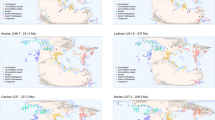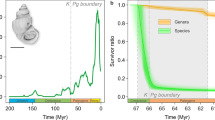Abstract
The recent hypothesis that mass extinctions are discrete phenomena that have occurred with great regularity during the history of life1,2 is testable in several ways. Two essential elements of the hypothesis are (1) that each extinction event represents a significant departure from normal, or ‘background’, rates of extinction, and (2) that such mass extinction events are spaced equally in time. The analyses of the cyclicity of mass extinctions so far have concentrated on the past 250 Myr, with the first event occuring at the Permian–Triassic boundary, 245 Myr ago1–5. The second event followed 26–33 Myr later1–6, in the late Triassic. Here I present a detailed analysis of the fossil record of marine and non-marine life during the late Triassic which suggests that there were at least two phases of mass extinction during that time, separated by 12–17 Myr.
This is a preview of subscription content, access via your institution
Access options
Subscribe to this journal
Receive 51 print issues and online access
$199.00 per year
only $3.90 per issue
Buy this article
- Purchase on Springer Link
- Instant access to full article PDF
Prices may be subject to local taxes which are calculated during checkout
Similar content being viewed by others
References
Raup, D. M. & Sepkoski, J. J. Jr Proc. natn. Acad. Sci. U.S.A. 81, 801–805 (1984).
Raup, D. M. & Sepkoski, J. J. Jr Science 231, 833–836 (1986).
Rampino, M. R. & Stothers, R. B. Nature 308, 709–712 (1984).
Kitchell, J. A. & Pena, D. Science 226, 689–692 (1984).
Hoffman, A. Nature 315, 659–662 (1985).
Hoffman, A. & Ghiold, J. Geol. Mag. 122, 1–4 (1985).
Colbert, E. H. Proc. natn. Acad. Sci. U.S.A. 44, 973–977 (1958).
Newell, N. D. J. Paleont. 36, 592–610 (1962); Spec. Pap. geol. Soc. Am. 89, 63–91 (1967).
Raup, D. M. & Sepkoski, J. J. Jr Science 215, 1501–1503 (1982).
Sepkoski, J. J. Jr Spec. Pap. geol. Soc. Am. 190, 283–289 (1982); Paleobiology 10, 246–267 (1984).
Hallam, A. Paelaeogeogr. Palaeoclimatol. Palaeoecol. 35, 1–44 (1981).
Tozer, E. T. in The Ammonoidea (eds House, M. R. & Senior, J. R.) 66–100, 397–431 (Academic, London, 1980).
Kennedy, W. J. in Patterns of Evolution as Illustrated by the Fossil Record (ed. Hallam, A.) 251–304 (Elsevier, Amsterdam, 1977).
Charig, A. J. in Studies in Vertebrate Evolution (eds Joysey, K. A. & Kemp, T. S.) 121–155 (Oliver & Boyd, Edinburgh, 1972).
Bakker, R. in Patterns of Evolution as Illustrated by the Fossil Record (ed. Hallam, A.) 439–468 (Elsevier, Amsterdam, 1977).
Olson, E. C. Spec. Pap. geol. Soc. Am. 190, 501–511 (1982).
Benton, M. J. Q. Rev. Biol. 58, 29–55 (1983).
Benton, M. J. in The Beginning of the Age of Dinosaurs (ed. Padian, K.) (Cambridge University Press, New York, in the press).
Harland, W. B. et al. A Geologic Time Scale (Cambridge University Press, 1982).
Odin, G.S. (ed.) Numerical Dating in Stratigraphy (Wiley, New York, 1982).
Palmer, A. R. Geology 11, 503–504 (1983).
Donovan, B. T., Callomon, J. H. & Howarth, M. K. in The Ammonoidea (eds House, M. K. & Senior, J. R.) 101–155 (Academic, London, 1980).
Van Valen, L. M. Nature 307, 50–52 (1984).
Anderson, J. M. & Cruickshank, A. R. I. Palaeont. afr. 21, 15–44 (1978).
Olsen, P. E. & Galton, P. M. Science 197, 983–986 (1977).
Olsen, P. E. & Galton, P. M. Palaeont. afr. 25, 87–110 (1984).
Sepkoski, J. J. Jr Milwaukee publ. Mus. Contr. Geol. Biol. 51, 1–125 (1982) (with revision sheets dated August 1985).
Benton, M. J. Nature 316, 811–814 (1985); Bull. Soc. géol. Fr. (in the press).
Benton, M. J. Spec. Pap. Palaeont. 33, 185–202 (1985).
Moore, R. C. et al. (eds) Treatise on Invertebrate Paleontology (Geological Society of America and University of Kansas Press, Lawrence, 1953–1985).
Harland, W. B. et al. The Fossil Record (Geological Society of London, 1967).
Whalley, P. E. S. Bull. Br. Mus. not. Hist. (Geol.) 39, 107–187 (1985).
Sepkoski, J. J. Jr & Raup, D. M. in Dynamics of Extinction (ed. Elliott, D.) 3–36 (Wiley, Somerset, New Jersey, 1986).
Bray, A. A. Mod. Geol. 9, 397–409 (1985).
Hallam, A. Nature 319, 765–768 (1986).
Author information
Authors and Affiliations
Rights and permissions
About this article
Cite this article
Benton, M. More than one event in the late Triassic mass extinction. Nature 321, 857–861 (1986). https://doi.org/10.1038/321857a0
Received:
Accepted:
Issue Date:
DOI: https://doi.org/10.1038/321857a0
This article is cited by
-
A millimeter-scale insight into formation mechanism of lacustrine black shale in tephra deposition background
Scientific Reports (2022)
-
Stratigraphy of the upper Gondwana formations around Sohagpur, western part of the Satpura Gondwana Basin, Central India
Journal of the Geological Society of India (2016)
-
Can oncology recapitulate paleontology? Lessons from species extinctions
Nature Reviews Clinical Oncology (2015)
-
Carnian (Triassic) aridization on the Levant margin: evidence from the M1 member, Mohilla Formation, Makhtesh Ramon, south Israel
Facies (2013)
-
Evidence for a late Triassic multiple impact event on Earth
Nature (1998)
Comments
By submitting a comment you agree to abide by our Terms and Community Guidelines. If you find something abusive or that does not comply with our terms or guidelines please flag it as inappropriate.



